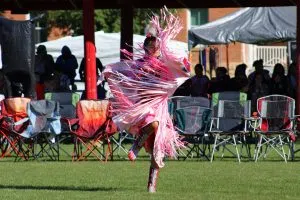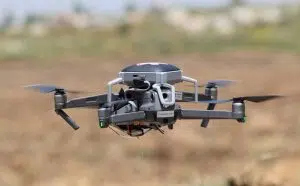
Paloma Ruiz of Parshall, North Dakota, dances during the United Tribes Technical College International Powwow in Bismarck on Sept. 6, 2024. Fourth graders from several area schools attended to learn about Plains Indian culture. (Michael Achterling/North Dakota Monitor)
(North Dakota Monitor) -Zariah Whiteplume walked into the grassy Lone Star Arena carrying more than a dozen iridescent hoops.
“I hope this dance brings you good feelings,” Whiteplume, a student at United Tribes Technical College, told her young audience. “And if you like what you see, please feel free to give a round of applause.”
As the music picked up, she began to hoist the hoops into the air, arranging them into increasingly elaborate shapes.

At one point she shuffled them into the figure of a horse, and swung her fist in the air like a cowboy with a lasso. The crowd erupted into cheers.
Fourth graders from more than 10 area schools packed into the Lone Star Arena at United Tribes Technical College on Friday morning to watch Whiteplume and four of her peers dance.
The presentation coincided with the 54th annual United Tribes Technical College International Powwow, a celebration of Native culture that includes competitive dancing and drumming.
For Bismarck fourth graders, it’s a chance to learn about Native history and traditions.
“It’s nice to have it especially at the beginning of the year because our fourth grade curriculum ties into Native North Dakota culture,” said Haley Wald, a fourth grade teacher at Centennial Elementary School.
Teachers who participate in Youth Day always give positive feedback, said Randi Waln, a teacher at Theodore Jamerson Elementary School and organizer for the event.
“The kids and teachers just enjoy watching the performances and learning about the history of the dances,” she said.

Selma Ruiz of Parshall, North Dakota, participates in youth day of the United Tribes Technical College International Powwow Sept. 6, 2024, in Bismarck. (Michael Achterling/North Dakota Monitor)

Jack Ruiz of Parshall, North Dakota, dances during the United Tribes Technical College International Powwow Sept. 6, 2024, in Bismarck. (Michael Achterling/North Dakota Monitor)

Dancers, from left, Selma Ruiz, Anaye Laducer, Paloma Ruiz and Zariah Whiteplume participate in youth day during the United Tribes Technical College International Powwow on Sept. 6, 2024, in Bismarck. (Michael Achterling/North Dakota Monitor)

Zariah Whiteplume dances during the United Tribes Technical College International Powwow on Sept. 6, 2024, in Bismarck. Whiteplume, who is from the Wind River Reservation in Wyoming, has been hoop dancing since she was young. (Michael Achterling/North Dakota Monitor)

Paloma Ruiz of Parshall, North Dakota, participates in youth day of the United Tribes Technical College International Powwow on Sept. 6, 2024, in Bismarck. (Michael Achterling/North Dakota Monitor)
In addition to Whiteplume, other dancers included Anaye Laducer and siblings Jack Ruiz, Selma Ruiz and Paloma Ruiz.
Whiteplume is from Wyoming’s Wind River Reservation and is of Navajo and Northern Arapaho heritage. Laducer and the Ruiz family are citizens of the Mandan, Hidatsa and Arikara Nation.
Randi Hart, who is the mother of the Ruiz siblings, introduced each of the dancers — who are all in high school or college — and shared a bit about their dancing styles.
No two dances were the same. “It’s about staying on beat and in rhythm to the song,” Hart said.
Jack Ruiz, who dances chicken style, went first.
Chicken style dancing is meant to mimic how roosters attract mates, Hart explained.
The participants wore regalia as unique as their dances.
Selma Ruiz — who dances northern traditional style — wore a beaded buckskin dress, breastplate and shawl, and carried a purse and eagle feather fan.
It’s a lot to wear while dancing, Hart noted.
“Selma makes that look incredibly easy,” she said after the performance, “But in reality, everything she has on is almost 50 pounds.”
Most of the fourth graders stayed absorbed in the performances the entire time, occasionally breaking concentration to whisper to their friends or swat away bees.
At the end, Hart invited the students onto the grass for one last dance.
They swarmed the arena floor, and joined hands with the performers as they circled the flagpole.









